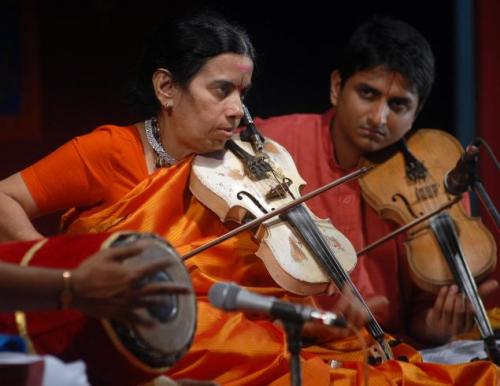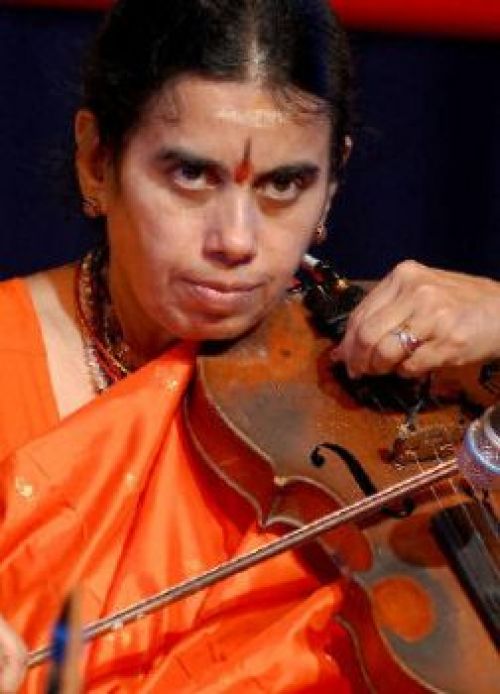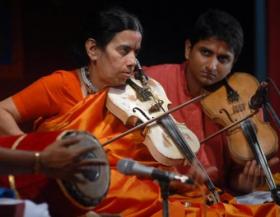
As part of Naradha Gana Sabha series, Vidhushi.Kanyakumari supported by Embar S.Kannan presented a reverberating violin duet concert. Able, but very subdued support by K.V.Prasad and B.S.Purushottam on Kanjira made the concert a wholesome experience in terms of content and communication.
After successfully dodging the chaotic traffic and parking, I reached finally reached the venue. Artists had just begun to play their main, Kalyana Vasantham, which had a brilliant display of speed and spontaneity in the delineation. Kannan’s follow up, filling up, were soulful, unhindering and highlighted his guru’s playing.
 Kanyakumari played a questionable, Dikshitar Krithi “Sri Venkatesam’ in Kalyana Vasantham. However, the fact that the charanam has the raga name embedded cleverly as done in most other Dikshitar Krithis (“Shri Bhudevi Sahitha Nitya Kalyaana Vasanthotsava Priyakaram”) and the madhyama kaala part at the end of charanam, do not make it a krithi by Dikshitar.
Kanyakumari played a questionable, Dikshitar Krithi “Sri Venkatesam’ in Kalyana Vasantham. However, the fact that the charanam has the raga name embedded cleverly as done in most other Dikshitar Krithis (“Shri Bhudevi Sahitha Nitya Kalyaana Vasanthotsava Priyakaram”) and the madhyama kaala part at the end of charanam, do not make it a krithi by Dikshitar.
Though the ending “Shri Guruguhadhi Poojidhabjakaram Kaliyuga Prasannam” has the signature of Dikshitar, some old timers claim that this was cheap handy work of some clever composer to push his work as Diskhitar’s composition.
Regardless, the krithi is a beautiful one and the kalpana swara exchanges were quite pleasing. The speed of rendering of this krithi was probably not suited to the meaning of the Krithi. Perhaps, the “Jarugandi” phrase at the Venkatesa Sannidhaanam in Thirupati, was ringing in the minds of the artist to do it as a hurried presentation!
Most Dikshitar krithis’s are set in slow tempo, especially this one. Had somebody sung this Krithi in the speed it was played, the beauty of the composition would have been certainly lost.
The main was Mohanam and the krithi was the ever green Nannu Palimpa. Once again the raga, alternatively played by the guru and the disciple, had majesty and melody mixed in measure. Kanyakumari’s neckbreaking speedy sangathis were reflected and responded to with equally fascinating speed – a delight! The anupallavi “Vanaja Nayana Momunu” showed its influence on anupallavi of Papanasam Sivan’s “Kapali”. Devoid of words, played on instrument, they sound almost similar.
The Echo electronics of Kanyakumari’s violin was a bit distracting and led to a feeling of delayed playing by a second Kanyakumari. Using electronics is OK for amplification when there are many instruments, but for a Carnatic concert? I am sure, Kanyakumari’s playing would have sounded even more beautiful, without that reverb.
Thani by K.V.Prasad and B.S.Purushottam was thoroughly enjoyable as it was short, sweet and with right amount of volume expected of percussive instruments. A noticeable aspect of both players was the way the played with a lot of heavy and soft syllables while uttering Konnakkol. It was trulyadmirable play.
They did not amplify their sound artificially to blast the ears of rasikas, but still effectively showcased their skill tastefully! The Thoppi handling in some places added to beauty of this volume controlled display. In short, it was not blasting, ear tearing play that one gets these days from accompanying artists, but a pleasant and pleasing one.
Followed by Thukkadas, a ragamalika in blistering speed and another one in Dwijavanthi, a thillana, Kanyakumari’s own composition was played in the ragam Sindhu Bhairavi.
When a thillana is played on instrument, if the rasikas don’t hear the words, the impact, regardless of how beautiful the piece, is lost. At least, the words of the sahithyam should have been sung. The success of Lalgudi Thillana’s is exactly because of that.
Many musicians have sung them and so the rasikas can relate to them and understand the placement of syllables “thirana”, “thillana” or other “sols”. Will Vidhushi Kanyakumari consider this in her next concert? BTW, I heard that they played the same Thillana during the academy concert and Kannan sang it for audience. NGS rasikas were probably not that lucky!
Sindhu Bhairavi followed Sindhu Bhairavi.
No, what you read is not a typo! They played Venkachala Nilayam, a popular Dasar padam following the thillana, which was again in SB. A quick play of Bhagyadha Lakshmi Bharamma and Mangalam concluded the concert.








